Apr 22, 2018 | Australia, Canada, coins, news
The royal mints in the Commonwealth Realm are have returned to court with the Royal Canadian Mint accusing the Royal Australian Mint of stealing the technology it uses to print coins.
In January, it was reported that the Royal Canadian Mint file a patent infringement lawsuit against the Royal Australian Mint when the Aussies issued 2012 Remembrance Day coins that the Canucks claim uses the same or similar technologies.
It is being reported that in March, the Royal Canadian Mint filed additional documents in the Federal Court of Australia claiming that the printing method on the coin that commemorates the Australian children’s book Possum Magic also infringes on their patents.
The original claim included the 500,000 coin run from 2012. With this updated filing to include other Remembrance Day coins, Olympic-themed coins, and other commemorative, the total is now 15 million Australian $2 coins. The Royal Canadian Mint wants all of the coins in the Royal Australian Mint’s possession to be turned over or “destroy(ed) under supervision.”
As part of their defense, the Royal Australian Mint is asking the courts to invalidate the patents claiming there is not enough novelty over previous methods. Those who watch technology patent fights here in the United States have heard this argument before.
A hearing is scheduled for June. More claims and counter-claims can be added to this lawsuit between now and then. Stay tune!
And now the news…

April 16, 2018
What can you give your country for its 70th anniversary? For thousands of school pupils and volunteers, the answer is the sweat of their brows as they worked to prepare a new public 70-kilometer (43-mile) walking path called the Sanhedrin Trail.  → Read more at timesofisrael.com
→ Read more at timesofisrael.com

April 16, 2018
An amateur archaeologist and a 13-year-old student have uncovered a stash of thousand-year-old coins, rings and pearls on an island in the Baltic Sea in northern Germany, including items that might be tied to Harald Bluetooth, the famous king who united Denmark.  → Read more at npr.org
→ Read more at npr.org

April 16, 2018
OTTAWA — A legal battle between the Royal Canadian Mint and its counterpart in Australia is heating up as Canada cries foul over “Possum Magic” coins. The Canadian Crown corporation is alleging the Royal Australian Mint stole its method for printing colour onto metal, and has expanded a December lawsuit over red poppies on a run of 2012 Remembrance Day coins.  → Read more at nationalpost.com
→ Read more at nationalpost.com

April 18, 2018
Maloney, author of the Purple Heart Hall of Honor Commemorative Coin Act, commended Purple Heart Hall of Honor, Inc. after it announced its “Campaign for 290,” which aims to attract at least 290 cosponsors to Rep. Maloney’s legislation by Memorial Day.  → Read more at hudsonvalleynewsnetwork.com
→ Read more at hudsonvalleynewsnetwork.com

April 19, 2018
The "Half Eagle" is 164 years old and one of only four known  → Read more at heraldtribune.com
→ Read more at heraldtribune.com

April 19, 2018
The Royal Canadian Mint claims an Australian Possum Magic-themed coin infringes on their patent.  → Read more at bbc.com
→ Read more at bbc.com

April 19, 2018
The Ernst Badian Collection gives insight to Roman history, as well as the evolution of currency.  → Read more at njtvonline.org
→ Read more at njtvonline.org

April 19, 2018
Silver is, like gold, a commodity store of value and is free of counterparty risk, with energy-intensive replacement costs setting the lower boundary for prices (the same energy proof of value that underlies gold prices).  → Read more at goldmoney.com
→ Read more at goldmoney.com

April 19, 2018
The Royal Canadian Mint, which is the official maker of the country’s money, has said the commemorative Australian series, which celebrates the classic Mem Fox children’s book Possum Magic, ripped off its unique process of painting colour onto metal.  → Read more at news.com.au
→ Read more at news.com.au

April 20, 2018
A former Bank of Japan employee was arrested Friday for allegedly stealing gold coins worth a total of ¥200,000 ($1,850) from the central bank’s Tokyo head office, police said. Koichi Yakushiji, 54, is suspected of stealing the two gold coins on April 2, the police said.  → Read more at japantimes.co.jp
→ Read more at japantimes.co.jp
Apr 8, 2018 | Canada, coins, commentary, nclt, news
The Royal Canadian Mint has officially Jumped the Shark!

2018 Canada $20 coin commemorates the 1967 Falcon Lake alleged UFO incident. (Source: Royal Canadian Mint)
Popular usage has been those times when a show, company, or anyone does something so outlandish to attract attention that was once lost.
One might say that the Royal Canadian Mint might have jumped the shark in the past, but they have really outdone themselves this time. They issued a one-ounce silver, $20 face-value non-circulating legal tender (NCLT) coin to commemorate an alleged UFO sighting.
When it goes on sale, the will cost $129.95 ($101.69 USD).
Aside from being 6.22-times the spot price of silver, the design is printed on the egg-shaped planchet. There appears to be nothing about the coin that is struck.
I have heard some say that things the U.S. Mint is doing is bad for the hobby. Some have targeted the American Liberty 22th Anniversary Gold Coin as being over the top. Although I have a problem with the coins having a high premium over spot prices, the coin pales in comparison to the UFO and other lenticular coins being offered by the Royal Canadian Mint.
And now the news…

April 2, 2018
Sales in March of U.S. Mint American Eagle gold fell to their lowest for the month, and silver coins dropped to their lowest in 11 years, government data showed.  → Read more at cnbc.com
→ Read more at cnbc.com

April 2, 2018
Scientists are left wondering how the coins remained hidden for so long.  → Read more at newsweek.com
→ Read more at newsweek.com

April 2, 2018
A Long Island businessman who built a textile empire by peddling irregular sweaters at local flea markets thought he had a fool-proof way to boost his assets — invest in a pal’s coin business. Bad …  → Read more at nypost.com
→ Read more at nypost.com

April 3, 2018
The oval-shaped coin immortalizes Stefan Michalak’s experience in Whiteshell Provincial Park, more than 50 years ago in what became known as the Falcon Lake incident.  → Read more at thestar.com
→ Read more at thestar.com

April 3, 2018
The Royal Canadian Mint has released a new $20 coin to commemorate one of Canada's closest encounters with a UFO.  → Read more at ctvnews.ca
→ Read more at ctvnews.ca

April 5, 2018
Now that the nation has a $1.3 trillion budget, lawmakers can resume debate about whether to pinch pennies. The threat to do away with pennies and nickels  → Read more at newsherald.com
→ Read more at newsherald.com

April 5, 2018
A trove of bronze coins, the last remnants of an ancient Jewish revolt against the Roman Empire, have been discovered near the Temple Mount in Jerusalem.  → Read more at foxnews.com
→ Read more at foxnews.com

April 5, 2018
Medieval coins dating back 800 years have been unearthed in north Shropshire.  → Read more at shropshirestar.com
→ Read more at shropshirestar.com
Mar 11, 2018 | Canada, coins, commemorative, news, silver, US Mint
It was announced that the Royal Canadian Mint was issuing a silver Canadian dollar commemorating the 180th Anniversary of Baseball in Canada. Being a baseball fan, I went to the Royal Canadian Mint’s website to see if the coin was worth adding to my collection. The came sticker shock!
The coin is convex, similar to the 2014 Baseball Hall of Fame commemorative coins issued by the U.S. Mint. But that is where the similarities end. The reverse of the Canadian coin features a vintage baseball scene reminiscent of the 19th century inside a baseball-looking design. The obverse has the portrait of Queen Elizabeth II. It has a face value of $25 CDN.
-

-
Reverse of the 180th Anniversary of Canadian Baseball coin (Image courtesy of the Royal Canadian Mint)
-
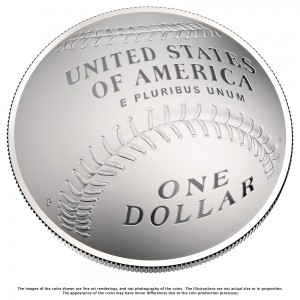
-
Reverse design of the 2014 Baseball Hall of Fame commemorative (Image courtesy of the U.S. Mint)
Then there are the specifications. When I visited the Royal Canadian Mint’s website, I was floored when I noticed the issue price of 159.95 CAD or about $124.82 at the current exchange rate. Here is a comparison of the coins:
|
Royal Canadian Mint
180th Anniversary of Canadian Baseball |
U.S. Mint
2014 Hall of Fame Commemorative Silver Dollar |
| Mintage |
5,000 (limit) |
400,000 (actual)
Proof: 268,076
Unc: 131,924 |
| Face Value |
25.00 CAD |
1.00 USD |
| Composition |
99.99% pure silver |
90% silver
10% copper |
| Weight |
30.75 g
(0.9886 troy ounce) |
29.73 g
(0.9558 troy ounce) |
| Diameter |
36.07 mm |
38.1 mm |
Silver Value
(16.57 USD spot) |
16.38 USD |
14.25 USD |
Issue Price
(1 CAD = 0.78 USD) |
159.95 CAD
(124.82 USD) |
Proof: $56.95 (preorder: $51.95)
Unc: $52.95 (preorder: $47.95) |
If you want a baseball commemorative coin and do not want to break the bank, you can still find the 2014 Baseball Hall of Fame Commemorative Silver Dollar within 20-percent of the issue price in original government packaging (OGP). Even though the artwork is very good, the price of the Canadian coin is too high. At a premium of over 970-percent over spot, it is difficult to justify.
And now the news…

March 5, 2018
The Central Bank of Lithuania is calling on tech companies and blockchain experts from across the globe to help in the design and production of a digital collector coin. The Central Bank is organising a hackathon in May for third parties to help in the design and development of the one-off virtual currency.  → Read more at finextra.com
→ Read more at finextra.com

March 6, 2018
A new commemorative coin was unveiled Oct. 9 to mark the 100th anniversary of the end of World War I and honor those Americans who served. The silver dollar coin, authorized by Congress in 2014, features a service member holding a rifle to honor those who fought in the war from 1914 to 1918.  → Read more at wadenapj.com
→ Read more at wadenapj.com

March 6, 2018
Major League Baseball came to Canada in the 20th century with the debut of the Montreal Expos in 1969 and the Toronto Blue Jays in 1977, but that was far from the beginning of the country's history with the game.  → Read more at mlb.com
→ Read more at mlb.com

March 6, 2018
SPRINGFIELD, Ill. (WAND) – A design is needed for the Bicentennial Coin to commemorate the Illinois Bicentennial. Illinois State Treasurer Michael Frerichs announced the Bicentennial Coin Contest on Tuesday.  → Read more at wandtv.com
→ Read more at wandtv.com

March 7, 2018
Reverse of new penny design, showing Abraham Lincoln and the Illinois State Capitol in Springfield. (U.S. Mint photo)  → Read more at chicagotribune.com
→ Read more at chicagotribune.com

March 7, 2018
The Royal Mint is encouraging coin lovers to celebrate the UK “one coin at a time”. The new series of 10p coins were released into circulation on March 1 and features an A to Z of British landmarks, icons and traditions.  → Read more at dailystar.co.uk
→ Read more at dailystar.co.uk

March 8, 2018
A museum has started a bid to buy part of a gold sovereign hoard discovered hidden inside a piano. The find was made in 2016 in Shropshire when the piano's new owners had it retuned and repaired. It has since been declared as treasure.  → Read more at bbc.com
→ Read more at bbc.com
Jan 21, 2018 | Australia, Canada, coins, commentary, news
One of the more interesting news items is that the Royal Canadian Mint is suing the Royal Australian Mint.
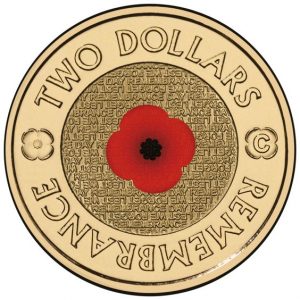
The Royal Canadian Mint alleges the Royal Australian Mint infringed on its patents when creating the 2012 Remembrance Day $2 coin.
Reports state that the two sides have tried to discuss the matter over the last two years. When no agreement had been reached, the Royal Canadian Mint decided to sue for relief. The Royal Canadian Mint is demanding that Australia hand over all 500,000 of the Remembrance Day coins struck or “destroyed under supervision.”
Since the Royal Canadian Mint is a crown corporation, it is an independent entity of the Canadian government. It has its own corporate and governance structure mandated by law. For those in the United States, it is similar to the relationship that Fannie Mae and Freddy Mac have with the United States government. On the other hand, the Royal Australian Mint is an agency in the Australian government in the same manner that the U.S. Mint is an agency in the United States government. Therefore, the Royal Canadian Mint is suing the Commonwealth of Australia.
“The applicant has suffered, and will continue to suffer, loss and damage by reason of the acts of the respondent pleaded above,” the statement of claim filed by the Royal Canadian Mint reads. Really? The Royal Canadian Mint has suffered because the Royal Australian Mint created a coin with a colored poppy for sale and distribution in Australia?
If the Royal Australian Mint infringed on the Royal Canadian Mint patent then there may be a case for relief owed for using the technology. But if the Royal Canadian Mint is trying to make a case based on the suffering of damages from sales of circulating versus commemorative coins, I think that the Royal Canadian Mint may be royally going in the wrong direction.
And now the news…

January 15, 2018
“At a time when our national debt is over $20 trillion, it is more and more difficult to find money for important things like cancer research,” – Congresswoman Carolyn Maloney.  → Read more at womensenews.org
→ Read more at womensenews.org

January 17, 2018
Online dealer sold 30kg of gold Tuesday, worth more than $1m Bitcoin tumbles below $10,000 for first time since December Amid the wild Bitcoin ride that’s wiped more than 40 percent off the cryptocurrency’s price in a month, a pattern may be emerging: sellers are switching out of digital gold and into the real thing.  → Read more at bloomberg.com
→ Read more at bloomberg.com

January 17, 2018
Gold’s liquidity and stability have made it an attractive option for investors in recent years. There are many ways to invest in gold. Investopedia lists gold futures, investing in old companies, gold EFTs, gold mutual funds, gold bullion, gold jewelry, and, of course, gold coins.  → Read more at newsmax.com
→ Read more at newsmax.com

January 17, 2018
After more than a year, visitors to the Nevada State Museum can watch the museum's historic Coin Press No. 1 carry on a mission it started nearly 150 year ago in the same building. The venerable press — which churned out millions of dollars in silver and gold coins during stints at U.S.  → Read more at nevadaappeal.com
→ Read more at nevadaappeal.com

January 18, 2018
OTTAWA — The Royal Canadian Mint is suing its Australian counterpart over the way it prints red poppies on its commemorative Remembrance Day coins. Documents filed in Australia’s Federal Court in December allege The Royal Australian Mint used without permission a printing method patented by the Canadian mint — which is now demanding that Australia’s 500,000 commemorative $2 coins, in circulation since 2012, either be turned over to them or “destroy(ed) under supervision.”  → Read more at nationalpost.com
→ Read more at nationalpost.com
Image courtesy of the Royal Australian Mint and had to be downloaded from Internet archives since it was deleted from their website.
Oct 31, 2017 | Canada, coins, nclt, silver
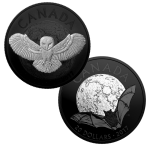 The Royal Canadian Mint has created two unique coins they call “Nocturnal by Nature” that would fit the theme of Halloween.
The Royal Canadian Mint has created two unique coins they call “Nocturnal by Nature” that would fit the theme of Halloween.
What makes them interesting is that the fields and some of the devices are plated with black rhodium to create a darkened look.
The first coin’s reverse, which is sold out, features a barn owl (Tyto alba) descending upon its prey. The view is looking up as the owl descends toward the night sky.
The second coin’s reverse has an image of a brown bat, darkened by night with its silhouette as it crosses passed the moon overhead.
-
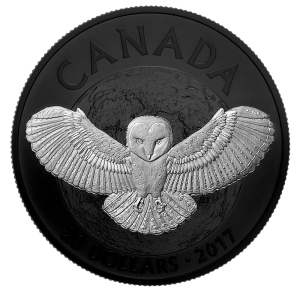
-
2017 Royal Canadian Mint Silver Nocturnal by Nature: The Barn Owl
-
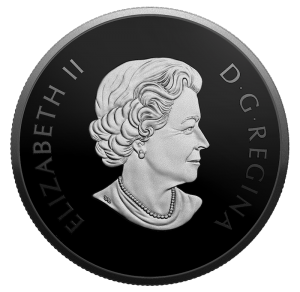
-
Obverse of the 2017 Nocturnal by Nature coins by the Royal Canadian Mint
-
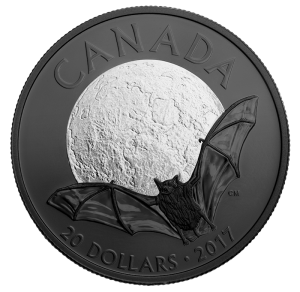
-
2017 Royal Canadian Mint Silver Nocturnal by Nature: The Little Brown Bat
As with all Canadian coins, the obverse features the official Royal Canadian Mint portrait of HM Queen Elizabeth II. The fields and legends are also plated with black rhodium that will make the Queen’s portrait really stand out.
Each coin is one troy ounce of .9999 silver, has serrated (reeded) edges, is 38 mm in diameter, and weighs 31.39 grams. Both coins have a face value of 20 dollars. The Royal Canadian Mint classifies the finish as matte proof.
Mintage is limited to 7,000 for each coin.
The single barn owl coin appears to be sold out on the Royal Canadian Mint website but looks like it can be purchased as part of their subscription program.
The price is listed at $119.95 CAD ($93.55 USD as I type this) for each coin with free shipping to Canada and the United States.
It may be too late for Halloween but they look very interesting!
All images courtesy of the Royal Canadian Mint.
Aug 6, 2017 | ANA, Canada, coins, news
I guess things went well at the American Numismatic Association World’s Fair of Money. There seems to have been a little reaction on social media and some input from the regular numismatic media, but for the most part, I am going to have to wait until my coin club meeting on Tuesday to speak with those who attended.
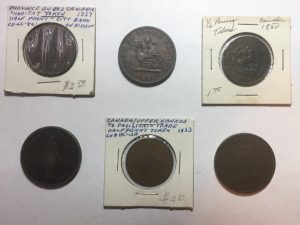
A recent purchase of six Canadian Tokens
Finally, I want to wish my brother Joel a Happy Birthday. I cannot believe the old man is 53!
July 31, 2017
As far back as he can remember, he has collected coins. As a young boy, he tagged along with his father to coin club meetings and exhibitions, gaining an interest in Canadian pennies and U.S. cents. "I don't remember not collecting," said Hallenbeck, who owns Hallenbeck Coin Gallery at 711 N. → Read more at gazette.com
July 31, 2017
OSKALOOSA — Jerry Jenkins, a former Oskaloosa resident who now lives in Texas, recently mailed two old coins to the Oskaloosa Herald. Jenkins said he wanted the coins to be donated to Nelson Pioneer Farm and Museum as part of Mahaska County history. → Read more at oskaloosa.com
July 31, 2017
BENGALURU: Investors and history lovers made a beeline this weekend for Nanyadarshini 2017. This was the first edition of the annual numismatics exhibition post-demonetisation by the Karnataka Numismatic Society at Shikshakara Bhawan on Kempegowda Road in the city. → Read more at economictimes.indiatimes.com
August 1, 2017
In 2013, David McCarthy spotted a rare coin in an auction catalog and immediately had a hunch it was the first coin minted by the fledgling United States of America in 1783. Not the first run of coins, mind you, but the very first one. → Read more at npr.org
August 1, 2017
WASHINGTON (AP) — Old inns along the Revolutionary War trails boast of George Washington sleeping there. But coin experts say they have found the first silver piece minted by the United States — one likely held by the most en vogue of Founding Fathers, Alexander Hamilton. → Read more at seattletimes.com
August 1, 2017
A picturesque stretch of land in Michigan’s Upper Peninsula is set to grace a special quarter the United States Mint unveils for 2018. The Pictured Rocks National Lakeshore is among the places featuring on the reverse side for the America the Beautiful Quarters program, officials announced Wednesday at the American Numismatics Association’s World’s Fair of Money. → Read more at detroitnews.com
August 2, 2017
The design for a coin representing Voyageurs National Park was unveiled this week along with the designs for four other national sites to be included in the United States Mint multi-year "America the Beautiful Quarters" program. → Read more at ifallsjournal.com
August 3, 2017
The Royal Mint is celebrating Prince Philip‘s retirement the same way they celebrate, well, all big royal milestones: with a new coin. The Queen‘s 96-year-old husband retired from official duties on Wednesday, after 64 years of service on behalf of the royal family. → Read more at people.com
August 3, 2017
ULAN BATOR, Aug. 3 (Xinhua) — The Central Bank of Mongolia has issued a commemorative coin dedicated to the Gobi brown bear which is on the verge of extinction. The coin made of pure silver has the shape of a circle with a diameter of 38.61 mm and a price of 300,000 togrog (122 U.S. dollars). → Read more at news.xinhuanet.com
August 3, 2017
Recently in The Hill, we heard former Reps. Jim Kolbe (R-Ariz.) and Tim Penny (D-Minn.) promote currency reforms as a way to save taxpayers money. Unfortunately, their proposed solution, The Currency Optimization, Innovation, and National Savings (COINS) Act of 2017, misses the mark completely and would move the country in exactly the wrong direction. → Read more at thehill.com
Jul 1, 2017 | Canada, celebration, coins

Canada Day, or Fête du Canada in the French-speaking areas, is Canada’s version of Independence Day. It celebrates the enactment of their Constitution on July 1, 1867. The Constitution Act of 1867 brought together Ontario, Quebec, Nova Scotia, and New Brunswick to create the Dominion of Canada. As a Dominion then an independent member of the Commonwealth Realm, Canadian history is a bit different from that of the United States but as interesting.
This year, Canada celebrates its 150th Anniversary. Joining in the celebration, the Royal Canadian Mint has been issuing many collector coins with various themes for collectors to celebrate. One of the most talked about coins is the circulating $2 coin called “Dance of the Spirits” that features the Northern Lights that glow in the dark.
-
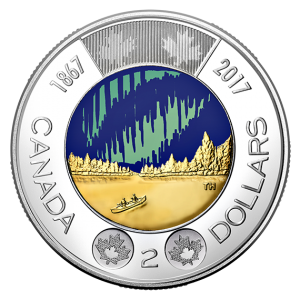
-
Reverse design of the 2017 Canada $2 “Dance of the Spirits” circulating coin
-
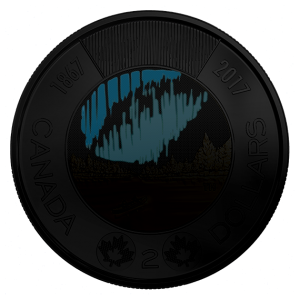
-
What the 2017 Canada $2 “Dance of the Spirits” reverse would look like in the dark
Collectors can purchase a 5-coin set of uncirculated Canada 150 circulation strike coins in a special folder from the Royal Canadian Mint for $19.95 CAD (currently $15.39 USD). For those who want the full set of uncirculated coins, the complete 12-coin set is available for $34.95 CAD ($26.95 USD).
-
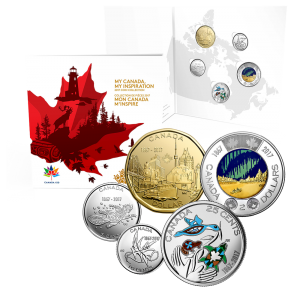
-
2017 Canada 150 5-Coin Collection
-
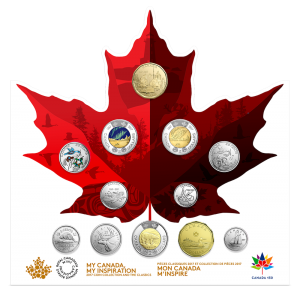
-
2017 Canada 150 Circulation 12-Coin Collection
If you can wait, the Royal Canadian Mint is scheduled to attend the World’s Fair of Money. Sometimes they offer discounts to those attending the show and they could be sold out of these sets! But if you are not going to make it to Denver, the Royal Canadian Mint is very good with shipping to the United States.
HAPPY CANADA DAY!
From your friends in the United States
Jun 3, 2017 | Canada, counterfeit, currency
 Police in Vancouver, British Columbia has discovered that criminals are altering the new polymer notes to create counterfeits that are being passed in the region. The Royal Canadian Mounted Police (RCMP) and the Bank of Canada are warning merchants that criminals are splicing $5 bills to remove the holographic strips and add them to color-copied $100 notes to make them seem less suspicious.
Police in Vancouver, British Columbia has discovered that criminals are altering the new polymer notes to create counterfeits that are being passed in the region. The Royal Canadian Mounted Police (RCMP) and the Bank of Canada are warning merchants that criminals are splicing $5 bills to remove the holographic strips and add them to color-copied $100 notes to make them seem less suspicious.
In order to make sure that the clear window in the polymer notes does not raise suspicion, clear packing tape has been used on the altered $5 notes to cover the alteration.
Discovered in Metro Vancouver, police found that a careful examination of the notes shows that the $5 notes can be altered in a way that does not raise suspicion while creating $100 notes that has been passed with little notice, until recently.
A representative from the Bank of Canada says that criminals are preying on the fact that people are not verifying the notes. The Bank of Canada issued a release urging merchants to check the notes for more than one of the security features.
Travelers to Canada and United States dealers that accept Canadian currency as a convenience to their customers from north of the border should learn about the embedded security features before accepting these notes. Visit the Bank of Canada Banknote website for more information as to how to recognize legitimate currency.
Clarification Update: The three lower denomination Canadian notes ($5, $10, and $20) are made using the polymer substrate. The higher denomination note ($50 and $100) are still made with rag bond paper. These notes are scheduled to be converted to polymer in the next few years.
-

-
Anti-counterfeiting features on the front of the Canadian polymer $20 note
-

-
Anti-counterfeiting features on the back of the Canadian polymer $20 note
All currency images courtesy of the Bank of Canada.
Feb 25, 2017 | BEP, books, Canada, counterfeit, history
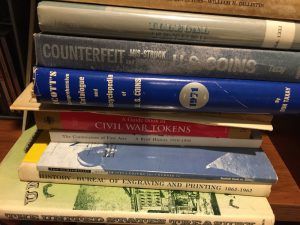 An adage of numismatics is “Buy the book before the coin.” It was first used by numismatist and dealer Aaron Feldman in an advertisement that appeared in the March 1966 issue of The Numismatist. Aside from being used to sell books, this sound advice tells collectors to enhance their knowledge of the hobby.
An adage of numismatics is “Buy the book before the coin.” It was first used by numismatist and dealer Aaron Feldman in an advertisement that appeared in the March 1966 issue of The Numismatist. Aside from being used to sell books, this sound advice tells collectors to enhance their knowledge of the hobby.
Education is important because helps build the skills and tools they need to navigate the world. Education helps us read, write, calculate and communicate. Without education, we would not be able to perform our jobs competently, accurately and safely. Education also gives us a view of the world which we live and provides a context to how we arrived at society today.
Numismatic education is important because it teaches us how to understand the and navigate the world of money and the economics that made it necessary. Without numismatic education coins, currency, bonds, tokens, and medals are just objects to be ogled without context. We would not know why these items are important or how to collect them. Numismatic education not only teaches us about how to identify these items and collect them but provides the background into history that explains how these items represent today’s society.
The areas I find interesting are the history and policies that have led to how things are today. History gives us the lessons learned as to how it was once done and the evolution of the policies that govern the way any institution is run. This is no different for the money manufacturing apparatus of the United States.
I have been on a book buying binge. If I find a book that will add to my curiosity, then it will become part of my growing library. Over the last few months, I have probably spent more on books than coins. With the exception of the few review copies (that I really should review), most of the books I buy are older and have information that I have not found anywhere else.
There are books from my new stack of older books I would like to highlight.
History of the Bureau of Engraving and Printing
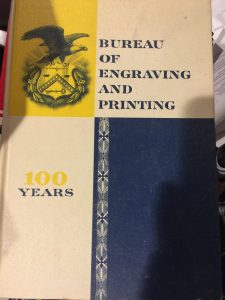
Bureau of Engraving and Printing, 100 Years
It is a beautifully produced book that stands out for its quality in both production and writing. The history of the BEP is well written with images of the process with images of some of the printing element interspersed throughout the text. Also included are intaglio printed images from the Bureau of Engraving and Printing archives. Between the pages with the intaglio prints is a tissue-like paper to help protect and preserve the images.
Although there are many good online histories of the Bureau of Engraving and Printing none of them are complete and does not include the other security printing history of the agency including bonds and stamps.
Three on Counterfeiting Currency
The most read post on the Coin Collectors Blog is “How easy is it to pass counterfeit currency.” I am fascinated that since I published that post there it has logged over 5,000 unique hits. I am sure that the post is being picked up by search engines and shown to people who are looking for illicit information. They are probably disappointed that the post is not an instruction manual, but I am fascinated that so many people would be interested.
It made me curious about the history of counterfeiting in the United States. Since I am on a book buying binge, it was time to find some interesting titles:
- Illegal Tender, Counterfeiting and the Secret Service in Nineteenth-Century America by David R. Johnson. To save money, this is a former library book in very good condition. I have skimmed this book and it looks like it will provide a good background as to the evolution of the U.S. Secret Service. The U.S. Secret Service is a unique agency. It was formed to investigate and deter counterfeiting of U.S. currency starting in 1865. They were so well respected that they were asked to protect President Theodore Roosevelt following the assassination of President William McKinley in 1901. Although many countries have divisions of their law enforcement services that investigate counterfeiting, the United States is the only country that has an agency whose mission to protect the currency from counterfeiting.

Banknote Reporters and Counterfeit Detectors from 1949
- Bank Note Reporters and Counterfeit Detectors, 1826-1866, by William H. Dillistin. Published by the American Numismatic Society in 1949, this book is a survey of experts in counterfeit detection that describes what to look for. It is also a catalog of publications in counterfeit detection and the authors. An interesting exercise may be to work on trying to find the papers and pamphlets listed in this book. I also liked the images in the back of the book that shows what to look for to detect counterfeits.
Illustrated History of Coins and Tokens Relating to Canada

Illustrated History of Coins and Tokens Relating to Canada by P.N. Breton
I have to admit to “picking” this book during a sale of books from my local coin club. The club is selling off items in its library that there seems to be little interest. Periodically, a few books are brought to a meeting and sold by silent auction. When Illustrated History of Coins and Tokens Relating to Canada, I did not pay attention. I was drawn that it was an older book about Canadian coins and that it is written in both French and English. What made this book stand out is that each page had two columns with the French text on the left and the English on the right. The format was fascinating I bid and won the book. Only after I started to go through my pile this past week to prioritize my reading list did I realize what I had purchased.
Although this is not a priority read, to have a contemporary reference about Breton Tokens written by P.N. Breton should make a fascinating read.
So… what’s on your bookshelf?
Feb 4, 2017 | Canada, coins, education, video
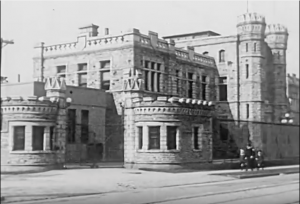
1920 Image of the Royal Canadian Mint in Ottawa
Take the video below, for example. It is titled “How money is Made” and appears to have been made for the Royal Canadian Mint by a company called Mogull Brothers Film Library in New York.
A quick bit of Internet research shows the company was founded and run by Charles Mogull (1898-1986) in Brooklyn, New York. Mogull Brothers were one of the early content creation pioneers. They would shoot a film on various subjects, edit them into smaller features, and sell the features to companies that would use them in larger compilations. Their content would be everything from features like the one they created for the Royal Canadian Mint, news events, interviews, show promotions, etc. and footage they would buy from photographers. The little information I could find on Mogull suggests that the company ceased operation in the late 1950s.
As for the film, the architecture of the original Royal Canadian Mint in Ottawa looks like a castle. I believe I read somewhere that the Royal Canadian Mint still uses the building as storage. To see this marvelous looking structure and to visit the Mint appears to be a good excuse to visit the Canadian capital.
It is a silent film that the person who posted it to YouTube added music. Even with the music, you can see how film technology has changed. Rather than being able to overlay the wording over the image, a process called keying, printed cards are used to describe the content and spliced into the film.
At the moment the film shows the making of the dies, they show the dies of a 1920 Canadian one cent coin with the image of George V. It was under George V, shortly after his ascension to the throne, that the Parliament Act 1911 transferred a lot of governing power to the House of Commons and started the erosion of monarch’s power.
Although we are well into the industrial revolution, the mix of automation and human interaction is fascinating. For example, starting around the 8-minute mark, there is a man bouncing the coins listening for its distinctive ring that silver coins make when bounced on a hard surface. Nowadays, machines with sensors and computers check the coins for quality. Even circulating coins are rarely touched by human hands.
Finally, as a little comic relief, when the film shows the title cards, look in the lower right corner at the graphics they chose to use. The filmmaker tried to use the graphics to emphasize something about what you will see next.
Now enjoy the show:

 → Read more at timesofisrael.com
→ Read more at timesofisrael.com → Read more at npr.org
→ Read more at npr.org → Read more at nationalpost.com
→ Read more at nationalpost.com → Read more at hudsonvalleynewsnetwork.com
→ Read more at hudsonvalleynewsnetwork.com → Read more at heraldtribune.com
→ Read more at heraldtribune.com → Read more at bbc.com
→ Read more at bbc.com → Read more at njtvonline.org
→ Read more at njtvonline.org → Read more at goldmoney.com
→ Read more at goldmoney.com → Read more at news.com.au
→ Read more at news.com.au → Read more at japantimes.co.jp
→ Read more at japantimes.co.jp





















